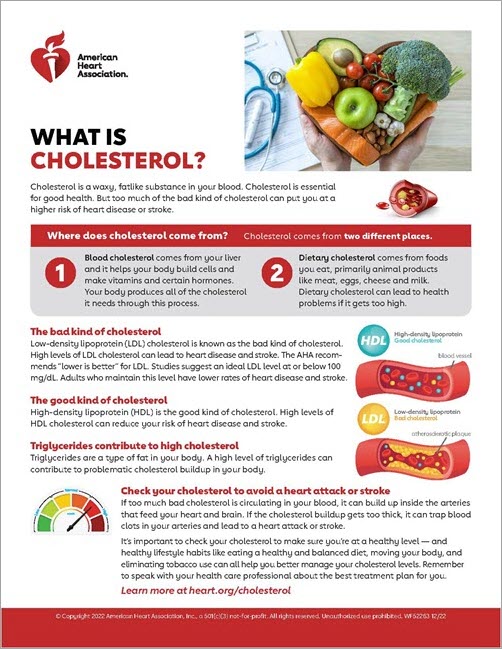What Is Cholesterol?
Quick Facts
- Your body makes cholesterol to build cells and make vitamins and hormones.
- Cholesterol also comes from food from animals.
- Too much cholesterol can cause problems. High cholesterol levels can increase your risk of heart disease and stroke.
Where does cholesterol come from?
If you’re reading this, you probably care about your health and the role cholesterol can play. That’s an important first step.
So, what is cholesterol? What does it do?
Cholesterol is a waxy substance throughout the body. It’s not “bad” unless you have too much of it. Your body needs it to build cells and make vitamins and other hormones. But too much cholesterol can pose a problem.
Cholesterol comes from two sources. Your liver makes all the cholesterol you need. The rest of the cholesterol in your body comes from foods from animals. For example, meat, poultry and dairy products all contain dietary cholesterol.
Those same foods can also be high in saturated and trans fats. These fats can increase the cholesterol in your body. For some people, this added cholesterol means they go from a normal cholesterol level to one that’s unhealthy.
Some tropical oils, such as palm oil, palm kernel oil and coconut oil, contain saturated fat that can increase bad cholesterol. These oils are often found in baked goods.
View What is Cholesterol? (PDF) | Spanish (PDF)
View an animation of cholesterol.
Why does cholesterol matter?
Cholesterol circulates in the blood. As the amount of cholesterol in your blood increases, so does the risk to your health. High cholesterol contributes to a higher risk of cardiovascular diseases, such as heart disease and stroke. It's important to have your cholesterol tested, so you can know your levels.
The two types of cholesterol are: LDL cholesterol, which is bad, and HDL, which is good. Too much of the bad kind or not enough of the good kind increases the risk that cholesterol will slowly build up in the inner walls of the arteries, such as those that feed the heart and brain.
Learn more about LDL, HDL and triglycerides.
Cholesterol can join with other substances to form a thick, hard deposit on the inside of the arteries. This narrows the arteries and makes them less flexible – a condition known as atherosclerosis. This can lead to a blood clot forming, which can block one of these narrowed arteries, causing a heart attack or stroke.
When it comes to cholesterol, remember: Check, change and control.
- Check your cholesterol levels. Know your numbers and assess your risk.
- Change your diet and lifestyle to help improve your levels.
- Control your cholesterol, with help from your health care professional if needed.
High cholesterol is one of the major controllable risk factors for coronary heart disease, heart attack and stroke. If you have other risk factors, such as smoking, high blood pressure or diabetes, your risk increases even more.
The more risk factors you have and the more severe they are, the higher your overall risk.
View the Consequences of High Cholesterol (PDF) | Spanish (PDF)







